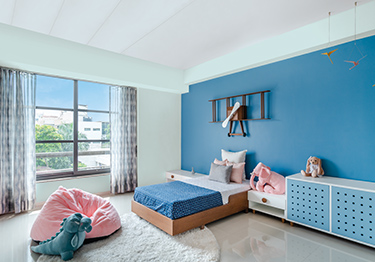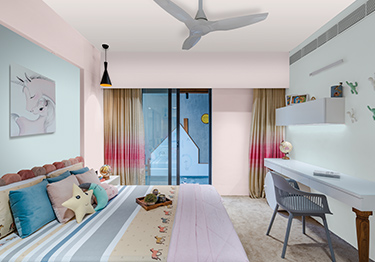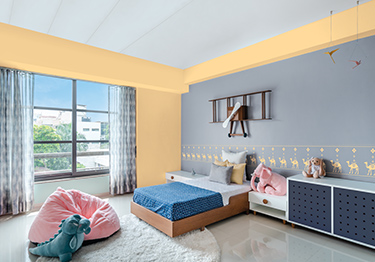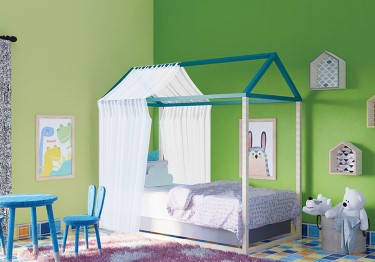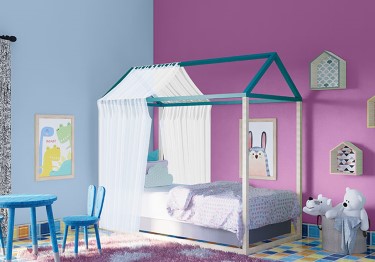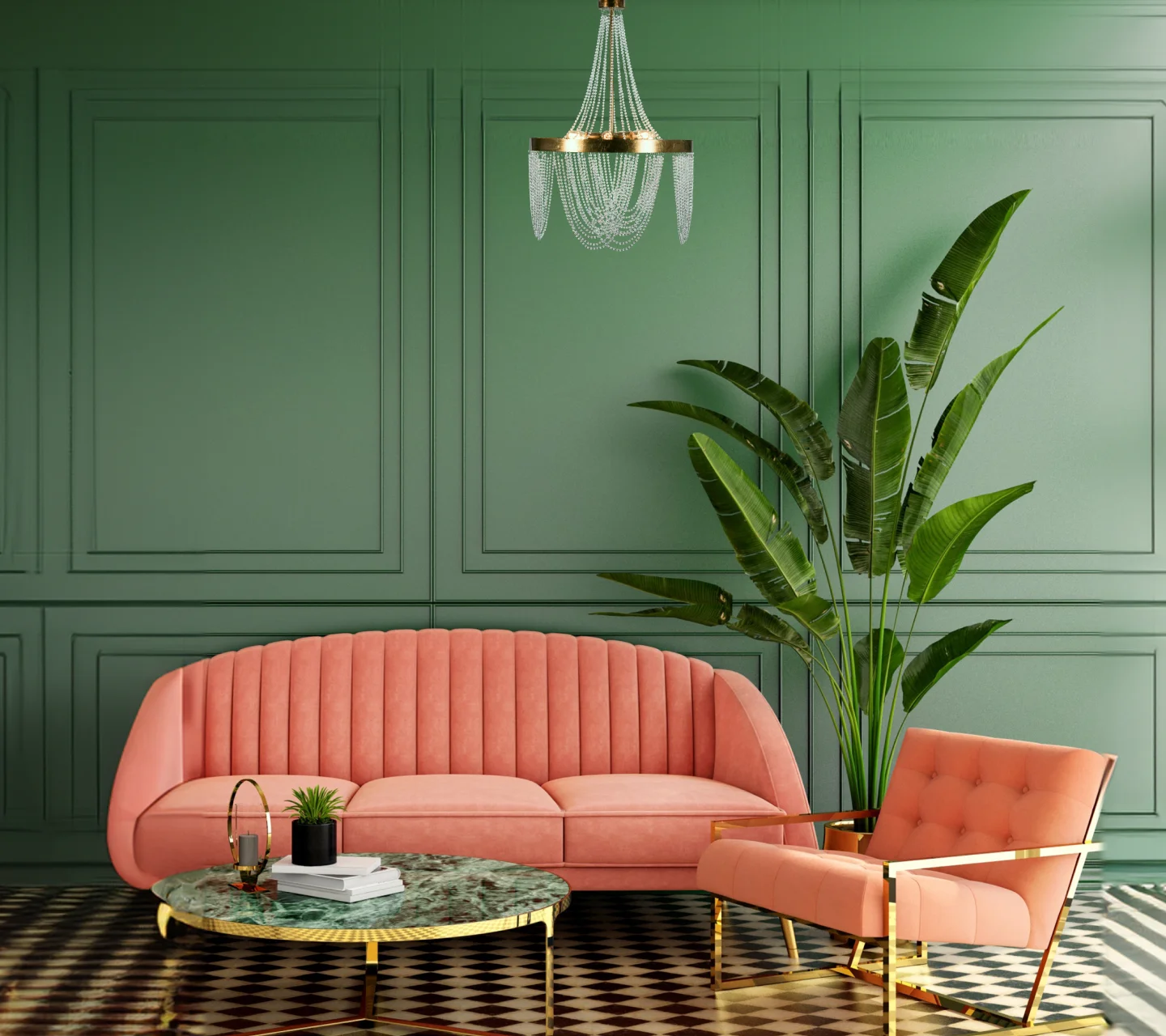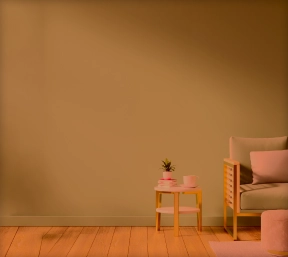FILTER BY
Kids room wall decor ideas
Let’s face it: Creativity is a must when it comes to designing your toddler’s room, and the right wall décor ideas will work wonders while creating a space that is youthful and fun. But hey, we also know that designing the best kids room wall décor, of course, comes with challenges.
The best way to overcome these challenges is by experimenting with fun wall décor, paints, wallpapers, or even wall storage to decorate your kid's room. You can even go all out to please your little one with prints, use bunnies, bees, or alphabets and then slowly move forward to popular toons, Disney princes and princesses, racing cars, and all-time superheroes.
Don’t shy away from choosing a fantastic range of kids room wall designs and themes to enhance the interiors and create a joyful space in your child’s bedroom.
Think like a kid to please a kid!
From childrens bedroom stickers and wallpapers to bright and happy textures, kids’ room walls need to be at par with their dreams and fantasies and as infinite as their thoughts. Get your little one involved in this design process and enjoy a family bonding exercise where you brainstorm, handpick colours and visualise together. Is it that simple? Yes! If you have the right colours, textures and theme in mind, then you’re on the road to sweet success!
Worry not, we are here to guide you through the process of choosing children's bedroom stickers and wall decals children's room seamlessly while ensuring it all adds up to fun times and a good nights’ sleep. Thank us later!
1. Children’s room wall painting ideas
From bright yellow hues to glistening turquoise blue, children's room wall painting ideas are limitless. But, before you hop into children's wall painting, let’s understand the kind of impact different colours have on your kids’ moods. One great colour idea that has a positive effect on your child is blue. It is said to be a soothing, peaceful hue that promotes happiness and instils calmness within children. Another colour option is yellow. It is a neutral shade that can bring in energy for toddlers and kids below the age of five. Opt for children's wall painting in bright and calming hues.
2. Wall texture design ideas for children
Apart from wall decals children's room and children's room wall paintings, you can design your kid’s room with fun textures like stripes, motifs, and flowers. You can also try experimenting with sea creatures, imprints, stamps, or anything quirky that inspires your kids and matches the overall fun-filled theme.
3. Wallpaper design ideas for children’s room
Cartoon characters like Chhota Bheema or Avengers are a hit among children. So, here’s your cue. Bring these characters to life by installing your kid’s favourite cartoon-themed wallpapers in their rooms. You can also try incorporating thematic children's room stickers like florals, geometric designs, and space motifs to add a fun and quirky element to your child’s room if they love underwater creatures, colours, or even the Milky Way! Choose the best wall children's room stickers or wallpapers that also match your kids' study room colour combinations.
4. Kids room wall sticker design ideas
Let children's wall stickers accentuate your child’s room and add a joyous charm to it. Try adding unique space-themed, jungle-themed, or aqua-themed children's wall stickers to relevant shades of navy blue, green and sea green/blue that can transform your kids’ room into their dreams. Decals and children's wall art stickers are great for kid’s room wall designs because they’re affordable, easy to apply and durable for kids' rooms, so you know just what to do next. You can also apply these children's wall art stickers to your kid's bathroom for an aesthetic look and that matches the bathroom colour combination.
Best kids room colours for walls
1. Soft Pink
Soft pink is often considered a good colour for children's wall painting or kids' room wall designs for a few reasons:
1. Calming and soothing:
Soft pink is usually associated with feelings of calmness, peace, and tranquillity. This can be particularly beneficial for kids, as it can create a relaxing ambience that helps them feel comfortable and secure.
2. Versatile and adaptable:
Soft pink is a versatile hue that can be easily adapted to different styles and themes. It can be paired with a range of other colours, such as white, grey, or blue, to create a calming and inviting space.
3. Cultural associations:
In several cultures, pink is associated with childhood, innocence, and purity. This can make it a particularly good choice for parents who want to create a nurturing and loving environment for their kids.
4. Personal preference:
Ultimately, the best colour for a kid’s room is the one that you and your child love the most.
2. Vivid Green
Vivid green is a great colour for a kid’s bedroom for numerous reasons:
1. Boosts creativity and learning:
Studies have shown that green can enhance concentration and focus. This is beneficial for kids who are doing their homework or studying.
2. Creates a sense of serenity and harmony:
Green is a versatile hue that can be used to create a variety of moods and styles. It can be paired with other colours to craft a soothing ambience, or it can be used on its own to make a dramatic statement.
3. Promotes health and well-being:
Green is linked with growth and renewal. Studies also show that it has a positive impact on physical and mental health.
4. Exhibits nature and the outdoors:
Green is the hue of grass, trees, and leaves. It can bring the outdoors into a child's bedroom and create a sense of connection with nature.
3. Gray
Gray is a well-loved choice for kid’s bedrooms for several reasons:
1. Neutrality:
Gray is a neutral colour that isn't linked with any specific gender or age group. This makes it a versatile choice that can evolve with your child as they transition from toddlerhood to adolescence.
2. Modern and Stylish:
Gray is a contemporary and chic colour that can give a kid’s bedroom an elegant look. It is also a timeless hue that will never go out of style.
3. Promotes Creativity:
Gray doesn't overstimulate the senses, making it an excellent choice for a room where children will spend time playing and learning. The lack of a dominant hue allows their imaginations to flourish.
4. Easy to Maintain:
Gray is a forgiving hue that doesn't show dirt and grime easily. This makes it a great choice for a kid’s bedroom, which is likely to see a lot of activity.
4. Off-White
Off-white is a wonderful colour choice for a kid’s bedroom for several reasons:
1. Versatility:
Off-white serves as a blank canvas, enabling you to easily change the room's look and personality as your child grows and their tastes evolve. Unlike bolder hues, it won't clash with wall decor children's room or furniture.
2. Adapts to Different Lighting:
Off-white reflects light well, making the room feel vibrant and airy, even in rooms with limited natural light. This is especially beneficial for compact bedrooms, as it can help them feel more spacious.
3. Timeless Appeal:
Off-white is a classic hue that never goes out of style. This means you won't have to refresh the room as often as your child grows up, saving you time, effort and money.
4. Works with Various Design Styles:
Off-white can be incorporated into several design styles, from minimalist and modern to traditional and whimsical.
5. Light Yellow
Light yellow is considered a good hue for a kid’s bedroom for several reasons:
1. Uplifting and cheerful:
Light yellow is linked with happiness, optimism, and sunshine. It can create a warm and welcoming atmosphere that promotes positive emotions in children.
2. Bright and airy:
Light yellow can make a compact room feel larger and more spacious.
3. Calming and relaxing:
While bright yellow can be stimulating, light yellow has a more calming effect. It can help children relax and unwind, which is especially beneficial during bedtime.
4. Enhanced concentration and memory:
Studies suggest that light yellow can boost concentration and memory in kids. This can be advantageous for activities like reading and homework.
FAQs on Kids Wall Ideas
How do I start designing a kid's room wall?
It’s simple! To begin with, analyse the room layout and understand your kids’ likes and dislikes. Once that is done, begin with choosing a colour palette, and a theme and create a visual for the child's room. Look for matching kids' room wall décor to accentuate the walls. Sit and brainstorm together with your kid on children's room wall painting ideas. If you’re not satisfied with the ideas, get in touch with expert designers to explain your vision to them.
What is the best paint for walls when you have kids?
Satin finish is one of the most preferred kids’ room wall painting ideas since they’re easy to wash, stain-resistant and durable while concealing wall imperfections. However, designers and painters generally prefer modern emulsion paints since they’re eco-friendly and easily washable, making it child-proof.
Can you have white walls with kids?
Yes, you can have white walls with kids when you’re using emulsion paints and have a strong semi-gloss finish. This is simply because a strong and durable finish protects the white paint from dust and stain, and makes it easily washable. So, even if your child has doodled all over the plain white wall, you can easily wash it off.
What are the latest kids' room colour ideas?
Let’s navigate through the latest kid’s room colour ideas ranging from vibrant schemes, and thematic combinations to monochromatic hues.
We have put together an inspiring list of the best children’s room colour combinations that will most definitely uplift their mood, increase focus, instil positivity, and bring in joy, of course!
1. Popular Room Colors for Girls: Pink is a classic colour that represents a young girl’s energy and innocence and is used to create inspiring and fun kid’s bedroom colour schemes for girls.
Besides pink, another popular room colour for girls is purple which can be paired with any lighter shade. You can also go with pastel palettes and neutral hues.
Pro-tip: For younger girls, use murals, stickers, motifs, and butterfly patterns.
2. Kids Room Colors for Boys: Popular kid’s room colours for boys range from muted shades of grey, green, and charcoal to vibrant reds and yellows. You can also opt for evergreen kid’s bedroom colour combinations like blue-grey, red-yellow, pastels, or yellow-orange. Try adding wall decor to children's rooms and furnishings to customise the space. Gain brownie points from your little one by adding murals, motifs, or decals of their choice!
3. Gender-Neutral Kids Room Colors: The best gender-neutral colour for a kid’s room would be blue or orange. You can use a classic kid’s room colour combination that can be paired with a vibrant accent colour like red, pink, purple, yellow, or white. Use white as the base colour and add colourful artwork, decor, furniture, and upholstery to it. Also, a gender-neutral colour theme like a sea theme, jungle theme, or mystical theme sounds work wonders for your kid’s room.
What is the best colour for a children's room according to Vastu?
It is believed that a room built following the vastu principles brings energy and positivity. Hence, it is important to consider it while designing your kid’s room.
Listed down below are the vastu-centric kid’s room paint colours that will spread happiness and bring in good luck for them:
● Kid’s room colour combinations like blue and white, yellow and white, and more radiate good energy and positivity.
● As per vastu, the best kid’s bedroom colour schemes are pink, blue, green, yellow, and even white.
● Purple is a common room colour for girls but can be used for both genders as it spreads positivity and promotes sound sleep.
● The best color for a kid's room to improve focus and concentration is green.
Why choose Asian Paints for kids' room paint colors?
Asian Paints has a wide variety of kid’s room colour ideas, children’s room colour combinations, and inspiring wall textures that can match your child’s imagination, dreams, and creativity.
Here are the five strong reasons why you must choose Asian Paints while designing your kid’s room:
● Limitless options: Handpick a theme from Asian Paints’ Kids World and enjoy limitless possibilities in the kid’s range for ceilings, stickers, and wallpapers
● Official Toon Merchandise: Choose from a wide range of toon-themed wallpapers and fun-filled themed stickers that can accentuate painted walls
● Wall Designs: Choose inspiring and edgy textures for teenagers and older kids. Explore a variety of wall colour combinations for the bedroom for your home and your kid's room colour inspiration.
What is the best color to paint a child's room?
Overall, when it comes to colour psychology, child growth and positive qualities, blue is the ideal color for a kid's room as it improves their concentration, behaviour, and mood. For younger kids who have just begun their schooling, green is the right choice.
What colour is most calming for kids?
Always opt for non-stimulating and non-aggravating colours in children’s rooms. Blue is the most calming colour for kids. It makes their room appear spacious, calm, and relaxing like the ocean or the vast sky. It also works best on children who are overactive and hyper-energetic.
You can also try other children’s room colours like pink, green, blue, orange, or yellow.
What colour makes kids happy?
When it comes to one single colour, yellow is said to represent the sun, happiness, and all things bright for children. Along with yellow, orange is another colour that spreads positivity, brightness, and youthfulness. As per colour psychology, vibrant colours like yellow, red, pink, orange, green, and blue make children happy.
What colours stimulate a child's brain?
For kids between the ages of 1 and 2 years, red, pink, and yellow stimulate cognitive development. Colours like yellow, orange, green, blue, orange, pink, and red improve learning and studying among children.
How can I choose wall colours that stimulate creativity and imagination in a kids' room?
Colours evoke distinct emotions and responses. Here are some hues known to stimulate creativity and imagination:
Bright and bold hues: Vibrant yellows, oranges, and greens can help stimulate the mind, fostering playfulness and exploration.
Serene blues and greens: These hues support calmness and focus, crafting a space conducive to daydreaming and imaginary adventures.
Earthy tones: Shades of brown and beige can offer a sense of grounding and security, encouraging relaxation and creative thinking.
How do I balance vibrant and playful colors without overwhelming the kids' room design?
Balancing vibrant and playful colours in a kid's room is all about crafting a space that is whimsical and fun, while also being soothing and restful. Here are some tips:
1. Use a dominant calming hue.
2. Add pops of vibrant colour.
3. When in doubt, use different shades of the same hue.
4. Use patterns sparingly.
5. Use furniture and accessories to craft different zones.
6. Keep in mind your child's age and personality.
Can you suggest wall design ideas that incorporate educational or interactive elements for kids?
Children’s bedrooms are their own little worlds, and the walls are a blank canvas just waiting to be converted into something magical and stimulating. The options are endless when it comes to creating an educational and interactive wall design for your child's bedroom. Here are some wall design ideas that incorporate educational or interactive elements, making their bedrooms fun and educational at the same time:
1. World map mural
2. Magnetic wall
3. Chalkboard wall
4. Growth chart
5. Interactive alphabet wall
Are there specific colour palettes that can grow with a child and adapt to different age stages?
Here are steps you can take so that the room adapts to the different age stages of the child -
Select a base colour: Select a few neutral hues like white, grey, or beige as a foundation for the space. This allows for easy adaptation to different stages and preferences by changing accent colours, accessories, and decor.
Use removable elements: Choose removable wallpaper, throw pillows, rugs, and artwork that can be easily swapped out as the child's taste evolves.
Incorporate modular furniture: Select furniture pieces that can be rearranged or combined to create different layouts and adapt to changing needs.
Encourage personal expression: Let your kid participate in selecting colours and decor elements that reflect their personality and interests.
How can I create a gender-neutral yet engaging wall design for a shared kids' room?
Crafting a shared kids' room that is both gender-neutral and engaging can be fun and rewarding. These are some ideas to get you started:
Nature: Choose a light and airy nature theme with soothing colours such as green, blue, and brown. Decorate with images of forests, beaches, mountains, oceans, or animals.
Space: Showcase the wonders of space with a starry night sky theme.
Underwater: Exhibit an underwater world with a cool and refreshing theme.
Travel: Foster wanderlust with a travel-themed wall.
Can you share tips on organizing and displaying kids' artwork as part of the room design?
1. Pick which areas in your home will be dedicated to displaying artwork.
2. Think creatively and use unorthodox ways to display artwork.
3. Scan or photograph your child's artwork and create digital collages or slideshows.
4. Add labels to artwork with the title, date, and a brief description of what inspired it.
5. Incorporate recessed lighting or picture lights to highlight the artwork.
6. Get creative and don’t forget to have fun! There are no limits to how you can display your child's artwork.



